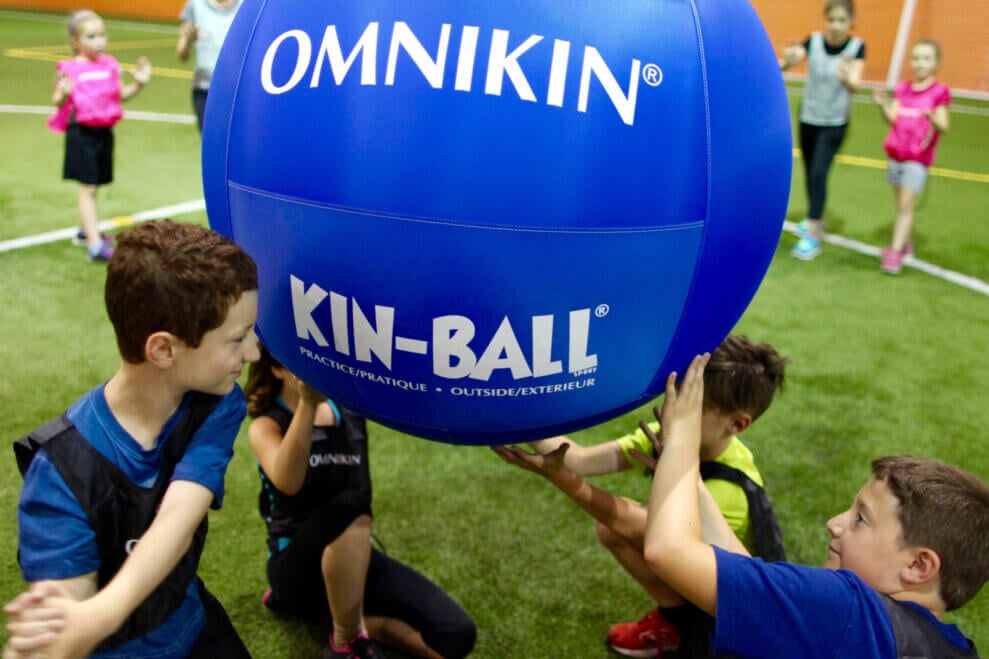
Kin-Ball: The amazingly fun sport you’ve probably never heard of
Every time we have a balloon at home we inevitably end up playing “don’t let the balloon touch the floor!” and everyone runs about lunging and laughing. Now picture a similar game being played with twelve kids, and a ball that’s four feet wide and filled with air.
This is Kin-Ball. And does it ever looks like a whole lot of fun.
I, admittedly, have never played it. It was while I was chatting online with friends from across Canada that I learned how popular the sport is in some parts of the country. Most of the adults excitedly recalled playing in tournaments, or have kids playing now in primary and high school.
“It’s really fun because there aren’t that many players on a team so you get many turns, and hitting the big ball is satisfying,” said one youngster who plays at school in Montreal.

Invented in 1986 by Mario Demers, a Canadian physical-education professor, Kin-Ball was first created to get kids moving and is now played around the world by people of all ages. It’s a fast-paced, interactive sport that engages a wide range of skills, while promoting physical activity, sportsmanship, and teamwork. It’s a sport for everyone, where teams achieve success only by working together.
The sport is unique in that it consists of three teams all competing at the same time, instead of the usual one-on-one of traditional team activities. The three teams of four players wear different colours to identify who’s on which team.
Teamwork and strategy are essential as players try to score points while trying to keep the giant ultra-light ball in the air. The server must call out “Omnikin!” and the colour of an opposite team (blue, grey, or black) before hitting the ball.
The aim is to throw the ball in such a way that the team called out cannot catch the ball before it touches the ground. If it falls, the two opposing teams score a point.
While the official court size for the sport is 66’×66’, it’s also played by kids and adults in gymnasiums, schoolyards, on the beach, or even in the snow!
Cooperation, accessibility, and sportsmanship are at the core of the sport, explains Pierre-Julien Hamel, director of the International Kin-Ball Sport Federation.
“Because of the size of the ball, kids have no choice but to cooperate to handle it, so the ball becomes like a tool of communication,” says Hamel. “It’s also a sport that places emphasis on the participation of everyone and is very accessible in terms of it not being too technical, so learning how to play is very easy.”
The minimum equipment needed is a ball from Omnikin and an air pump. The score can be recorded on a blackboard, and different coloured shirts or pinnies differentiate the three teams.
The sport is fantastic for elementary schools as the huge ball engages students right away, and everyone has equal involvement regardless of their abilities. It also contributes to developing many aspects of physical literacy, such as hand-eye coordination and full-body movement, and enhances cardiovascular fitness.
Early childhood education centres can adapt the rules to make an unstructured game suitable for preschoolers. How about creating a hilarious game of tag, or counting how long the ball can stay in the air before it touches the ground?
To find different ways to play with the ball, the manufacturer offers various workshops and training sessions.
For those who wish to play competitively, there are regional and provincial competitions, and the World Cup is held every three years. Fun fact: the Canadian women’s team remains undefeated in the history of Kin-Ball!
For more information on the sport, official rules, videos, and lesson plans visit: International Kin-Ball Sport Federation or Kin-Ball Canada.
Photos courtesy of Omnikin.





